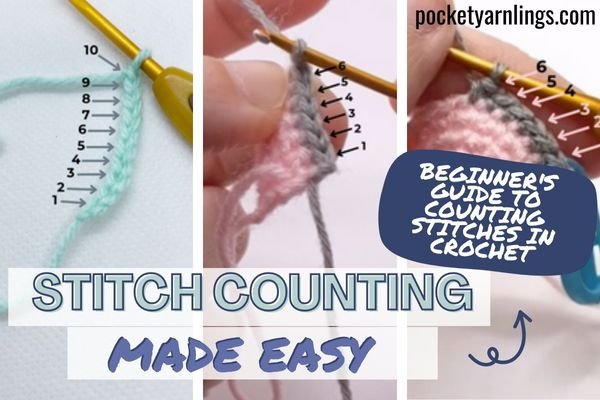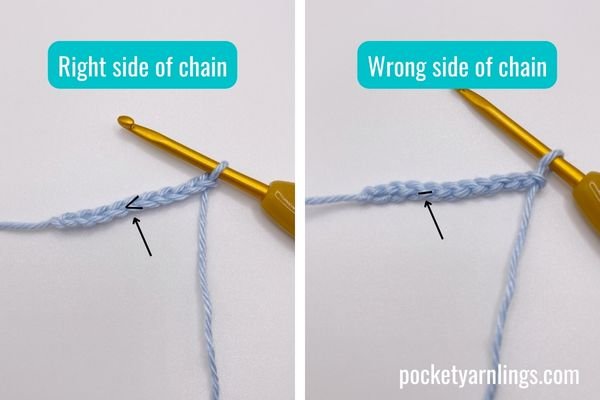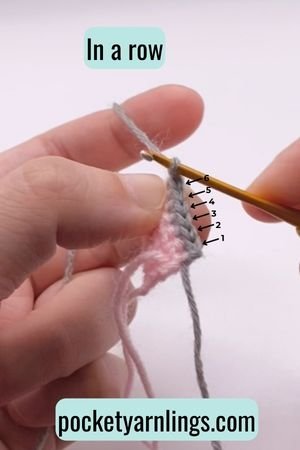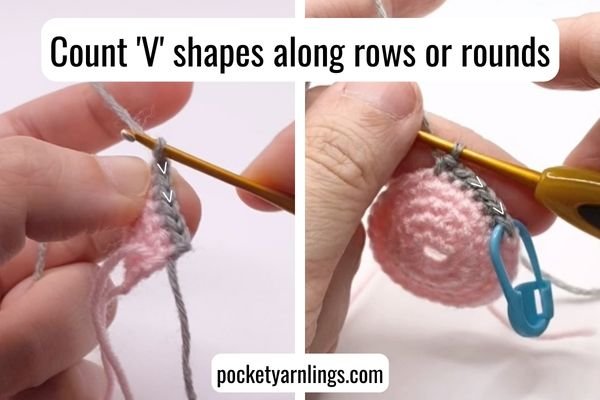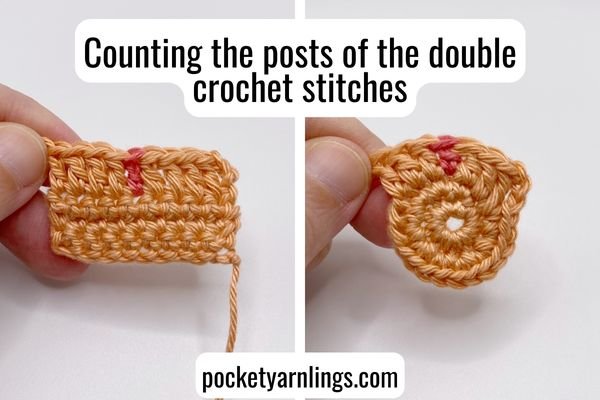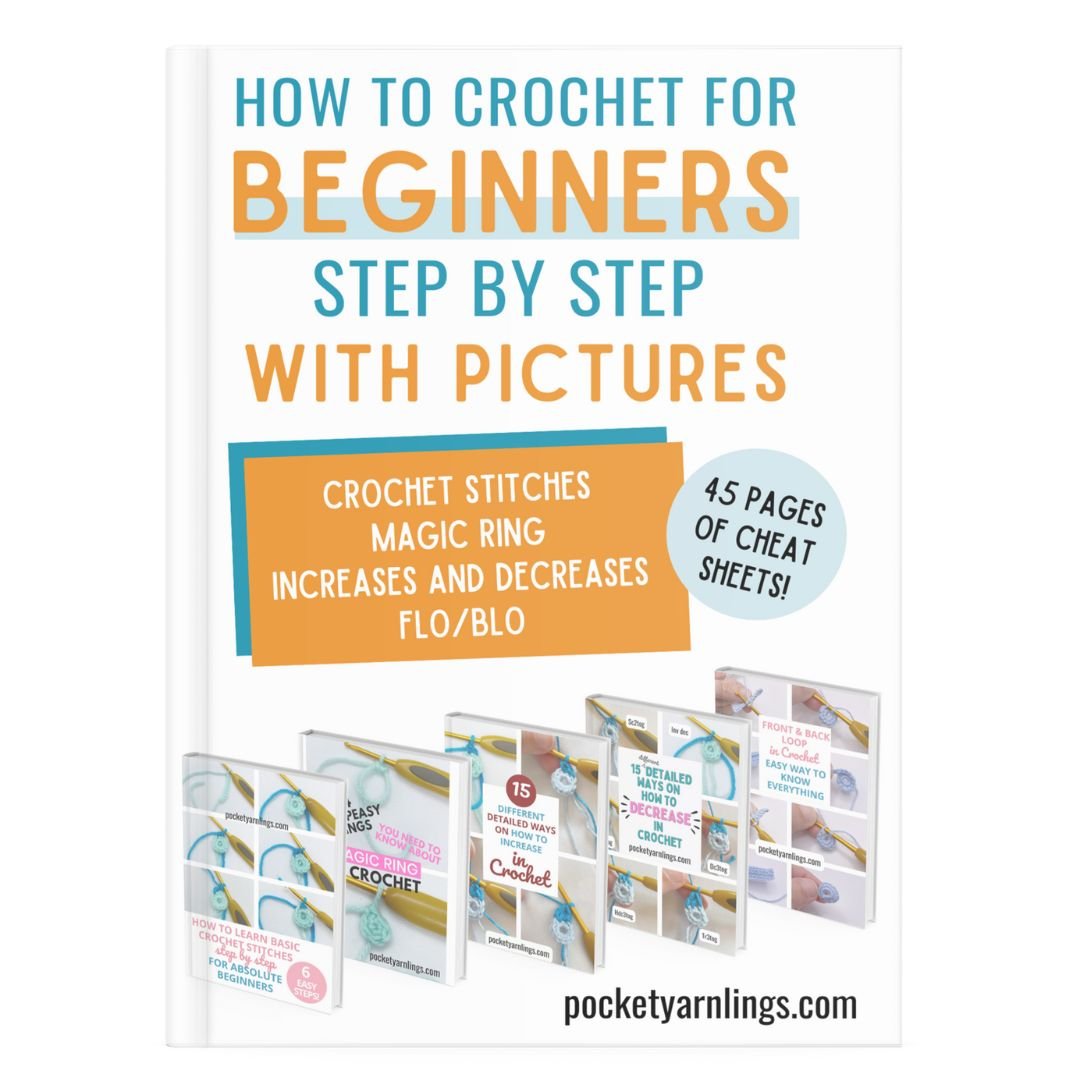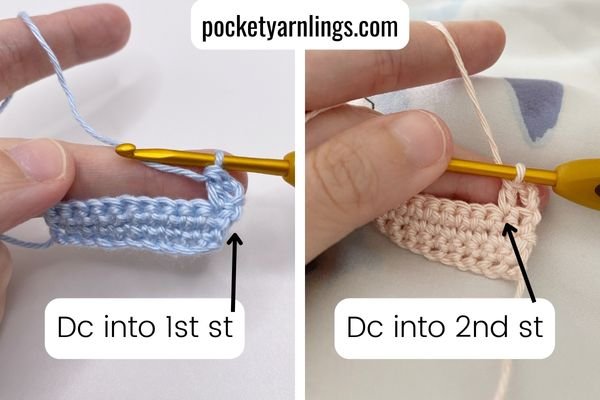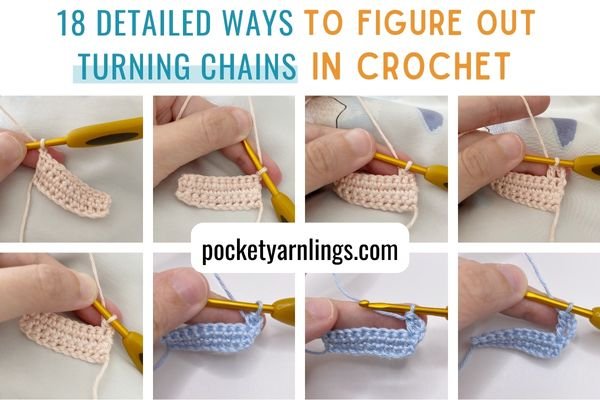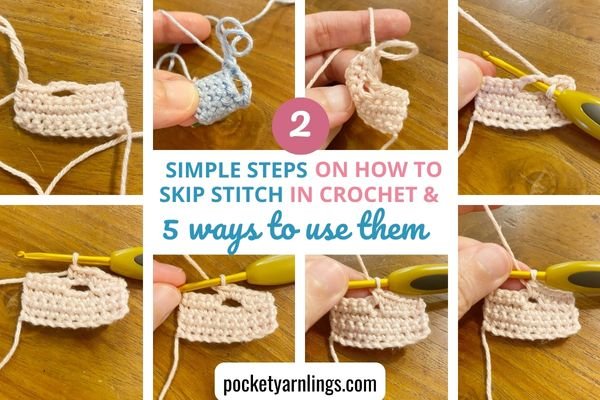Stitch Counting Made Easy: A Beginner's Guide to Counting Stitches in Crochet
Counting stitches is an essential skill for any crochet enthusiast. Whether you are a beginner or an experienced crocheter, keeping track of your stitches is crucial to ensuring that your project turns out the way you want it to.
Table of Contents Show
By counting your stitches, you can make sure that your rows are even and that your finished product is the right size.
*This blog post may contain affiliate links. When you make a purchase through my link, I may receive a small commission at no additional cost to you.*
Understanding Crochet Stitches
Crochet is a fun and creative hobby that allows you to make beautiful and unique items. Understanding crochet stitches is an essential part of this craft. In this section, you will learn why counting stitches is important and how it can help you create your crochet projects with ease.
Do You Need to Count Stitches When Crocheting?
Yes, counting stitches is an essential part of crocheting. It helps you keep track of the number of stitches in each row or round, which is important for maintaining the correct size and shape of your project. Counting stitches can also help you avoid mistakes, such as adding or skipping stitches, which can cause your project to be uneven or misshapen.
Why Do You Count the Stitches in Crochet?
Apart from the reasons mentioned above, including keep track of the number stitches to maintain the size and shape of your project, counting stitches can also help you identify where you made a mistake if you need to rip back a few rows. By counting the stitches in the previous row or round, you can easily identify where the mistake was made and fix it.
How do you count stitches when crocheting?
Crocheting is a fun and creative activity that requires you to count stitches to ensure that your pattern turns out correctly. Counting stitches can be a little tricky, especially if you are new to crocheting.
In general, there are two ways to count stitches, which I will intermittently mention below in the appropriate situations. The one method is to count the ‘v’ shapes along the stitches as you are working along and the second method is to count the ‘post’ of each stitch after they have been completed. I will elaborate on each method below when they are more relevant.
How to count crochet stitches in chain?
This is the most basic form of counting, the number of chains starting off in the foundation before crocheting in rows. Oftentimes, in crochet patterns, the chain part might not be included in the final stitch count of the row.To count the chains, look out for consecutive ‘v’ shapes without including the initial slip knot and the working loop on the hook as well.
How to count crochet stitches in rows?
Counting in row can be easier than counting the chains. Here the colour demarcation is for easier reference, Also, similarly look out for the ‘v’ shape along the row to count the stitches. Do note if you have a chain and a turn at the end, it is not counted into the row count. More on this will be elaborated on in turning chains later.
How to count crochet stitches in the round?
Here I have only counted the stitches in the latest round likewise by counting the ‘v’ shapes along the round, also demarcated in a different colour for easier reference.
It is easy to to lose count of your stitches when working in a round, which is why I would recommend adding stitch markers, like I did here, more on that later. You could also use a stray yarn to demarcate the start of the round, so that when you finish the round, you know to readjust the marker for the start of the next round.
How to Count Different Types of Stitches?
For this section, we will be counting slightly differently – we could either using the counting ‘v’ shape method or the counting ‘post’ method. As we have explored different crocheting situations above, this time we will be counting different types of basic crochet stitches – namely single crochet, half double, double and treble crochet stitches.
How to Count Single Crochet Stitches?
Single crochet stitches are the most basic and commonly used stitches in crocheting. To count them, you need to count the V-shaped loops on the top of the stitch. Each V-shaped loop represents one single crochet stitch. It is easier to count with this method over counting the posts as the posts of a single crochet row can be difficult to differentiate, as compared to treble crochet as you will see later.
How to Count Half Double Crochet Stitches?
Identify the ‘post’ of the stitch by locating the vertical bar created by each half double crochet stitch. These posts are the vertical sections between the loops on top of the stitch. Move along the row or round, counting each post as you come across – each post represents one half double crochet stitch. If you are not able to identify the posts, you could revert back to counting the ‘v’ shapes along the latest row or round.
How to Count Double Crochet Stitches?
Counting double crochet stitches is much like counting half double crochet stitches – by counting the posts. It actually might get easier to count the posts as the stitches get taller because each vertical bar becomes more obvious. Remember not to count in the turning chains as part of the stitch counts, especially if the turning chain is worked into the same stitch as the chain.
How to Count Treble Crochet Stitches?
Treble crochet stitches are the tallest of all the basic crochet stitches. To count them, you need to count either the vertical posts like what was mentioned for dc and hdc or the ‘v’ shapes along the latest row or round. Counting treble crochet stitches should be even easier as the vertical bars are more obvious for say half double crochet stitches.
If you find this blog post useful and want to reference back again later or you would love to share this with others, remember to pin to Pinterest!
Free Beginners Step-by-step Guide
Grab these 45-pages of cheat sheets that will help you with crochet stitches, magic rings, increases and decreases, FLO and BLO. Click on image on left for access!
Counting Crochet Stitches in Special Situations
When it comes to counting stitches while crocheting, there are some special situations that can be a bit confusing. Here are some common questions and answers to help you keep track of your stitches.
Do You Count the Stitch on Your Hook in Crochet?
No, you do not count the stitch on your hook when counting crochet stitches. When you count stitches in crochet, you count the stitches that are already completed and present in your project, not the stitch that is currently on your hook. The stitch on your hook is the one you are about to work into to create a new stitch.
Does the Slip Knot Count as a Stitch in Crochet?
No, the slip knot does not count as a stitch in crochet. The slip knot is used to begin your work, but it is not considered a stitch. When you are counting your stitches, be sure to start counting from the first stitch you make after the slip knot.
Does a Yarn Over Count as a Stitch in Crochet?
No, a yarn over (YO) does not count as a stitch in crochet. The yarn over is an essential part of the crochet process and is used to create new stitches, but it is not considered a stitch itself.
In crochet, a yarn over is the action of wrapping the yarn around the crochet hook before or between stitches. When counting stitches in crochet, you count the completed stitches that have been worked into the fabric, not the yarn overs. Yarn overs are part of the process that creates the stitches but are not counted separately.
Does the First Stitch Count as a Stitch in Crochet?
The first stitch in a row or round of crochet can be counted as a stitch or not, depending on the specific pattern or technique being used. Different patterns and techniques may treat the first stitch differently, so it's essential to refer to the instructions provided.
In some patterns, the first stitch of a row or round is considered a stitch and should be worked into like any other stitch. This is common in patterns that maintain a consistent stitch count throughout the project. This happens for the most part.
On the other hand, in certain patterns or techniques, the first stitch of a row or round may be treated differently. It may be skipped or substituted with a specific stitch, such as a turning chain. This is often done to achieve a specific stitch pattern or maintain the correct stitch alignment.
Does Turning Chain Count as a Stitch in Crochet?
It depends on the pattern you are working on. If you crochet into the first stitch of the row, after finishing the turning chain, and proceed to do a double crochet stitch into the same stitch, then that turning chain is not counted as a stitch, which is what is done most of the time.
Otherwise, if you finish your turning chain, then you skip the first stitch in the row and proceed with a dc stitch into the second stitch, then that turning chain counts as a stitch.
Be sure to read the pattern carefully to determine whether or not the turning chain should be included in your stitch count.
To learn more about turning chains, check out this article “18 detailed ways to figure out Turning Chains in Crochet”.
Common Mistakes While Counting Stitches
When it comes to crocheting, counting stitches is an essential part of the process. However, it's not uncommon to make mistakes while counting stitches, which can lead to frustration and even errors in your finished project. In this section, we'll discuss some of the most common mistakes you might encounter while counting stitches and how to avoid them.
Skipping Stitches
One of the most common mistakes people make while counting stitches is skipping stitches. This can happen when you get distracted or lose track of where you are in your pattern. When you skip stitches, you end up with too few stitches in your row, which can throw off the entire pattern.
To avoid skipping stitches, it's important to stay focused and keep track of where you are in your pattern. You can use stitch markers or a piece of scrap yarn to mark your place in the pattern, so you don't lose track.
On the other hand, if there are specific situations to skip stitches in crochet, you can read more about them in “2 simple steps on How to Skip Stitch in Crochet and 5 ways to use them”.
Miscounting Rows
Another common mistake when counting stitches is miscounting rows. This can happen when you're not paying attention or when you accidentally skip a row. Miscounting rows can lead to uneven edges or an overall misshapen project.
To avoid miscounting rows, it's important to double-check your work frequently. Count your stitches and rows after every few rows to make sure you're on track. You can also use a row counter to keep track of your progress.
Incorrect Stitch Identification
Finally, another common mistake when counting stitches is incorrect stitch identification. This can happen when you're not familiar with the stitches in your pattern or when you accidentally use the wrong stitch. Or sometimes perhaps counting turning chains when you are not supposed to or vice versa.
To avoid incorrect stitch identification, it's important to take your time and read your pattern carefully. Make sure you're familiar with all the stitches before you start your project. You can also use a stitch guide or tutorial to help you learn new stitches.
How to keep track of stitches in crochet?
Crocheting can be a relaxing and enjoyable hobby, but it can also be frustrating when you lose track of your stitches. Here are some tips on how to keep track of your stitches while crocheting.
Using Stitch Markers
Stitch markers are a great way to keep track of your stitches. You can use them to mark the beginning of a row or round, the end of a row, or any other important stitch. They come in a variety of shapes and sizes, such as locking stitch markers, split-ring stitch markers, and removable stitch markers. You can also use a contrasting colour of yarn as a stitch marker.
To learn more about stitch markers, check out this comprehensive article “10 Crochet Stitch Marker Types and their 10 easy Uses in Amigurumi”.
The Grid Method
The grid method is a way to keep track of your stitches by drawing a grid on paper that matches the size of your crochet project. You can use this method to keep track of where you are in your pattern and to count your stitches. You can also use the grid method to plan out your project before you start crocheting. I often use this method when doing colour work or even C2C crochet!
Noting Down Counts
Noting down counts is a simple way to keep track of your stitches. You can use a pen and paper, a notebook, or a crochet stitch counter to keep track of your stitches. You can also use this method to keep track of where you are in your pattern and to count your stitches. You could be old school like me and just key in the counts into your notepad on your phone or there are even some stitch counting apps you can download.
Crochet Stitch Counter
A crochet stitch counter is a device that helps you keep track of your stitches. It works like a tally counter, and you can use it to count your stitches as you go. Some stitch counters also have a row counter, which can help you keep track of where you are in your pattern.
Choose the method that works best for you and enjoy your crocheting!
How to count stitches in amigurumi?
Amigurumi is a popular crocheting technique that involves creating small stuffed animals and other cute objects. Counting stitches in amigurumi can be challenging, especially when working with small stitches and tight rounds.
To count stitches in amigurumi, use a stitch marker to mark the first stitch of each round. Then, count the number of stitches between each stitch marker to determine the total number of stitches in the round. If you make a mistake, it's easy to unravel a few stitches and start again.
Tips and Tricks for Easy Counting
Counting stitches while crocheting is an essential part of the process. However, it can be frustrating and time-consuming, especially for beginners. Here are some tips and tricks to make counting stitches easier and more efficient:
Use stitch markers: Placing a stitch marker after every ten or twenty stitches can help you keep track of your progress and make it easier to count your stitches. You can use different coloured markers to mark different sections of your work.
Count out loud: Counting out loud can help you stay focused and avoid losing track of your place. It may also help you catch mistakes and fix them before they become a bigger problem.
Count your stitches at the end of each row to make sure you have the correct number and make sure it tallies with the pattern suggested.
Use a row counter: A row counter is a handy tool that can help you keep track of the number of rows you have completed. You can attach it to your work or wear it around your neck for easy access.
Take breaks: Crocheting for long periods can be tiring and make it harder to count stitches accurately. Take frequent breaks to rest your eyes and hands, and to refresh your mind.
If you find this blog post useful and want to reference back again later, remember to pin to Pinterest!
Conclusion of Counting Stitches in Crochet
Counting stitches is an essential part of crocheting, and it can be a bit overwhelming at first. However, with practice, you will find that counting stitches becomes second nature, and you will be able to crochet with ease.
By counting stitches, you can ensure that your project turns out the way you want it to. Whether you are making a blanket, a hat, or an amigurumi, counting stitches will help you keep track of your progress and make sure that your stitches are even and consistent.
Remember, crocheting is supposed to be fun and relaxing. Don't stress too much about counting stitches. With practice, you will become more confident in your abilities, and you will be able to crochet without even thinking about it.
So, grab your hook and yarn, and start counting those stitches!
Free Beginners Step-by-step Guide
Grab these 45-pages of cheat sheets that will help you with crochet stitches, magic rings, increases and decreases, FLO and BLO. Click on image on left for access!
Related articles
How to Learn Basic Crochet Stitches step by step for Absolute Beginners - 6 Easy Steps!
Master the Art of Single Crochet Stitches: A Comprehensive Guide and Tips
Mastering Half Double Crochet Stitches: A Step-by-Step Guide and Tips
Mastering the Double Crochet Stitch: A Comprehensive Guide and Essential Techniques
Master the Treble Crochet Stitch: A Comprehensive Guide and Tips
Slip Stitch Crochet: A Comprehensive Beginner's Guide to Mastering the Technique


